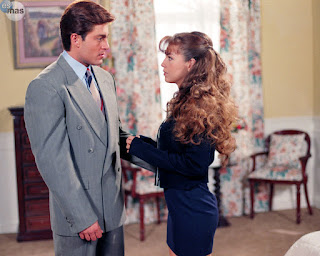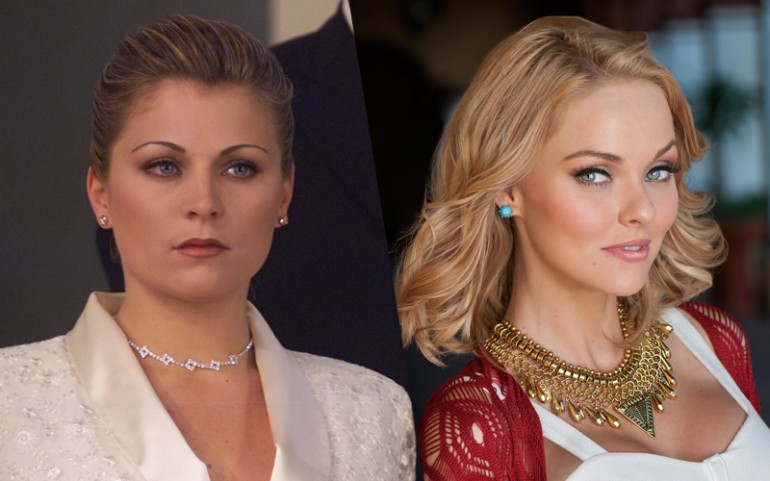Prince Not Charming
As I tune in to my telenovela, “Maria La Del Barrio,” I’ve been keeping in mind its classic Cinderella structure as we learned in class, but what I’ve found is a quite unconventional prince. The pilot introduces Maria as the extremely poor, orphaned Cinderella who is living with her godmother. Upon her godmother’s passing, Maria is placed in a rich benefactor’s home by the local priest, as her last dying wish. It was a clever choice to incorporate the godmother granting a wish for Maria’s class elevation in this format. What breaks the mold of Cinderella though, is the introduction of her dashing, but cynical prince, Luis Fernando. Although handsome and rich, Luis Fernando is initially vicious and bratty. After being dumped, he vows to make every woman he crosses paths with miserable, and our heroine, poor, innocent Maria is no exception. In true Cinderella fashion, Maria is smitten with the tall and dashing Luis Fernando at first sight, but he takes no pity or compassion to her condition. He is mean, spiteful, and classist, constantly making fun of Maria’s lack of social awareness and social norm differences. To make matters worse, he is even mean to his mom, coming off as a typical spoiled rich boy.
Maria also breaks the mold of our typical Cinderella though, as she is not so pure and proper as the fairytale. Though innocent and kind, Maria will not be walked all over. She stands up for herself, and even throws a few punches if necessary, adding a feminist twist to this classic character. Still, Maria is Cinderella at the end of the day and her youth and lack of world knowledge leaves her impressionable and susceptible to Luis Fernando’s mind games.
It is interesting to watch this spin on the co protagonist that is supposed to fill in the prince archetype, however, he almost seems like the antagonist, tricking Maria and toying with her heart. There is no doubt as to why this is one of the most watched and most famous novelas of all time as it was one of the first to introduce the enemies to lovers trope in a telenovela. At times though, I can’t help but wonder if it is truly enemies to lovers or more like villain to lover. It is not until, Luis Fernando finally matures and falls for Maria that we see his transition into prince charming. It was hard for me at first to root for him due to his originally evil and vindictive nature, however, the undeniable chemistry and tug and pull between the two is addictive, thus ultimately making for good tv and most importantly, a good telenovela. It was a daring but effective choice to step out of the traditional structure and make a not so charming, prince charming.



Este príncipe protagonista hace sentido. El fin justifica los medios en las telenovelas. Parece que la mayoría de los personajes del príncipe cometen errores y no son muy inteligentes. Mientras que Luis tiene una mala personalidad al principio y actúa como una antagonista, parece que crece y madura. Como muchos príncipes encantadores, supera sus errores para finalmente conseguir a la mujer. Él también tiene dos grandes características del príncipe encantador: rico y guapo.
ReplyDeleteI think it's interesting how your telenovela twists the standard Cinderella archetype a little bit, where the female protagonist is not necessarily the sweet and helpless type. This twist is not something we often see in the Cinderella role. I know in my telenovela, I've talked about how I think my character fills a lot of roles in the Cinderella archetype. However, unlike the female protagonist in your telenovela, she does have trouble standing up for herself. I think it is important to show women in entertainment who have a fierce attitude, strong sense of self-worth and don't let people walk all over them. In my opinion, this type of character can be very empowering, and give women someone to look up to, especially in a world where men who are like Luis Fernando, often take advantage kindness and vulnerability.
ReplyDeleteMe gusta la forma en que has destacado las similitudes y diferencias entre el arquetipo tradicional de Cenicienta y el que se encuentra en tu telenovela, "María La Del Barrio". En cierto modo, creo que hacen esto para resaltar la realidad detrás de la típica historia de Cenicienta. En la vida real, un príncipe encantador no va a dejar todo por una chica pobre e inocente. Creo, tal y como ha descrito en su telenovela, que los tiempos están cambiando y las mujeres ya no son estas personas indefensas. Me gusta el hecho de que la Cenicienta en esta historia se defiende a sí misma, como sería en la vida real, cuando se trata de un hombre que es un idiota, a pesar de cualquier diferencia de estatus socioeconómico. Creo que es genial destacar cómo una historia como esta ocurriría típicamente para dar una mayor representación de la realidad. He estado involucrado con un sinnúmero de hombres que son atractivos y quizás a un nivel social diferente al mío, y, al igual que María, me pongo más de pie porque no deberíamos aceptar ese tratamiento o esperar que alguien cambie por nosotros como en las películas. Me gusta mucho que esta telenovela en particular destaca que para mostrar a la gente que no siempre es amor a primera vista y puede tomar algunas experiencias difíciles para llegar a "feliz para siempre".
ReplyDeleteI love how you really dissected the classic Cinderella archetype and how your characters differ, Daniella! The same sort of thing happens in my telenovela, Rubí, where the main character is a sort of Cinderella. She is beautiful and comes from el barrio, but after that she strays far from the normal Cinderella. Much like the prince in your story, she takes the role of the villian. She is manipulative, vain, and selfish. However, unlike the prince she never changes. Anyways, I didn't know Maria La Del Barrio was the first telenovela with the enemies to lovers/villain to lover trope and it sounds super captivating. I'd love to check it out sometime.
ReplyDelete